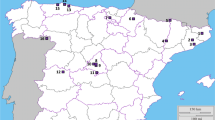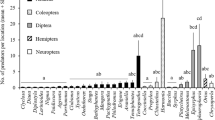Abstract
The major bioecological characteristics of Bracon intercessor Nees (Hymenoptera: Braconidae), a parasitoid of the poplar clearwing moth, Paranthrene tabaniformis (Rott.) (Lepidoptera: Sesiidae), were studied from 1987 to 2003. Poplar shoots infested with P. tabaniformis larvae were collected in 11 localities in Bulgaria and examined in the laboratory, and infestations were also studied in the field. B. intercessor was recorded in seven localities and was found to be a gregarious external larval parasitoid of P. tabaniformis. Two generations of the parasitoid developed on the host. The first (summer) generation was associated with early and mid-stage (up to third instar) host larvae, and the second (overwintering) generation with third- to fifth-instar larvae. The average number of parasitoid individuals feeding on a host was 4.5 and 12.4 in summer and overwintering generations, respectively. The maximum number recorded was 25 individuals per host in the overwintering generation. B. intercessor overwintered as a mature larva on the host and completed its development in early spring. The adults from the overwintering generation appeared in April, about 1 month prior to emergence of P. tabaniformis. The life cycle of B. intercessor was not in close synchrony with the development of P. tabaniformis in the spring, but the parasitoid adults which fed on honey-sugar solution lived for up to 31 days (males) and 86 days (females), respectively. This suggests that, in the field, B. intercessor females eclosing in the spring could survive until the host larvae appear if nectar is available. Adults of the summer generation emerge from July to September when sufficient suitable host larvae are available. B. intercessor was responsible for 1.5% of the average mortality of the P. tabaniformis overwintering larvae. The host mortality caused by the summer generation of the parasitoid ranged from 3.2% to 5.8%.



Similar content being viewed by others
References
Ceianu I (1962) Contributii la cunoasterea dannatorului Paranthrene tabaniformis Rott. (Lepidoptera, Aegeridae) in R.P.R. (in Romanian). Stud Cerc INCEF 22:91–115
Ceianu I, Radoi D, Konstantinescu E (1967) Paranthrene tabaniformis Rott. Cercetari cu privirela biologie si combatre (in Romanian; Russian, German summaries). Centrul de Documentare Tehnica Pentru Economia Forestiera, Bucaresti
de Freina JJ (1997) Die Bombyces und Sphinges der Westpalearktis. Band 4. Sesiidae. Forschung & Wissenschaft, München, pp 52–55
Georgiev G (1995a) The poplar clearwing moth, Paranthrene tabaniformis (Rottemburg, 1775), (Lepidoptera: Sesiidae)—biology, ecology and possibilities for controlling it in North Bulgaria (in Bulgarian). PhD thesis. Forest Research Institute, Sofia
Georgiev G (1995b) Phenology of the poplar clearwing moth (Paranthrene tabaniformis Rott., Lepidoptera: Aegeriidae) in Northern Bulgaria (in Bulgarian; English summary). For Sci 1:60–67
Georgiev G (2000a) Parasitoids of Paranthrene tabaniformis (Rott.) (Lepidoptera: Sesiidae) in Bulgaria (in Bulgarian; English summary). Ann Sofia Univ Fac Biol 92(1):121–126
Georgiev G (2000b) Studies on larval parasitoids of Paranthrene tabaniformis (Rott.) (Lepidoptera: Sesiidae) on urban poplars (Populus spp.) in Sofia, Bulgaria. Ann For Sci 57(2):181–186
Georgiev G (2001a) Notes on the biology and ecology of the parasitoids of the poplar clearwing moth, Paranthrene tabaniformis (Rott.) (Lepidoptera: Sesiidae) in Bulgaria. I. Apanteles evonymellae (Bouché, 1834) (Hym., Braconidae). J Appl Entomol 125(3):141–145
Georgiev G (2001b) Notes on the biology and ecology of the parasitoids of the poplar clearwing moth, Paranthrene tabaniformis (Rott.) (Lepidoptera: Sesiidae) in Bulgaria. II. Eriborus terebrans (Gravenhorst, 1826) (Hym., Ichneumonidae). J Appl Entomol 125(6):289–292
Georgiev G (2003) Annotated list of the parasitoids of poplar clearwing moth, Paranthrene tabaniformis (Rott.) (Lepidoptera: Sesiidae). In: Rossnev B (ed) Proceedings 75 Years of the Forest Research Institute of the Bulgarian Academy of Science. Part 2.. Forest Research Institute of the Bulgarian Academy of Science, Sofia, 1–5 October 2003. Forest Research Institute of the Bulgarian Academy of Science, Sofia, pp 217–222
Georgiev G, Delkov A (1997) Phytophagous insects and their parasitoids on poplar trees in Sofia (in Bulgarian; English summary). Acta Entomol Bulg 1–2:61–65
Georgiev G, Kolarov J (1999) New Ichneumonidae (Hymenoptera) parasitoids on forest insect pests in Bulgaria. Anz Schädlingsk 72(3):57–61
Georgiev G, Tsankov G (1995) Some parasitoid insect species on the larvae of the poplar clearwing moth (Paranthrene tabaniformis Rott., Lepidoptera: Sesiidae) in Bulgaria (in Bulgarian; English summary). For Sci 2:51–58
Hubenov Z, Georgiev G (1996) Phytomiptera nigrina (Meig.) (Diptera, Tachinidae)—new parasitoid of Paranthrene tabaniformis Rott. (Lepidoptera: Sesiidae) (in Bulgarian; English summary). For Sci 4:87–89
Kailidis DS (1962) Observations on the biology and control of Sciapteron tabaniformis Rott. in Greece, vol 6 (in Greek). Ministry of Agriculture, Directorate General of Forest and Mountain Hydronomy, Forest Research Institute, Athens, pp 1–15
Kolarov J, Georgiev G (1997) New Pimplinae (Hymenoptera, Ichneumonidae) parasitoids of poplar clearwing moth (Paranthrene tabaniformis Rott., Lepidoptera: Sesiidae) (in Bulgarian; English summary). For Sci 1(2):130–134
Szontagh P (1965) Az üvegszárnyú lepkék (fam. Aegeriidae) kártétele nyár anyatelepeken (in Hungarian; German summary). Erdeszeti Kut 17:257–275
Szontagh P (1971) Adatok a Paranthrene tabaniformis Rott. (Lepidoptera) fejlodesi es parazitaltsagi viszonyaihoz (in Hungarian; German summary). Folia Entomol Hung 24(7):99–108
Tobias VI (1986) Keys to the insects of the European part of the USSR (in Russian). Hymenoptera. Part 4, vol 3. Nauka, Leningrad
Turundaevskaya TM (1981) Clearwing moths—pests of tree species of the Western Kazakhstan (in Russian). Nauka, Moscow
Van Achterberg C, Hemminga MA, van Soelen J (1990) New host record of Bracon intercessor Nees f. megasomides Stand (Hymenoptera: Braconidae), a parasite of Agapanthia villosoviridescens DeGeer (Coleoptera: Cerambycidae) in salt marshes. Zool Meded 64:25–29
Acknowledgements
I am very grateful to Dr J. Papp from the Hungarian Natural History Museum, Budapest, for the identification of B. intercessor var. fulvus. I also would like to thank Dr L. Solter, Center for Economic Entomology, Illinois Natural History Survey, for her critical reading and correction of the English language version of the manuscript.
Author information
Authors and Affiliations
Corresponding author
Rights and permissions
About this article
Cite this article
Georgiev, G. Bioecological characteristics of Bracon intercessor Nees (Hymenoptera: Braconidae) as a parasitoid of the poplar clearwing moth, Paranthrene tabaniformis (Rott.) (Lepidoptera: Sesiidae) in Bulgaria. J Pest Sci 78, 161–165 (2005). https://doi.org/10.1007/s10340-005-0090-9
Received:
Published:
Issue Date:
DOI: https://doi.org/10.1007/s10340-005-0090-9




